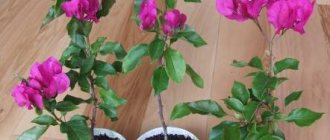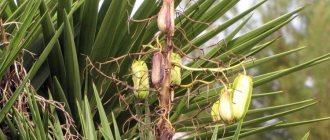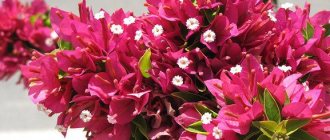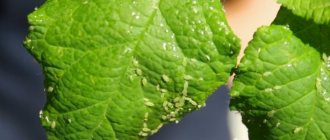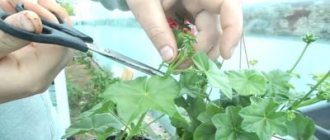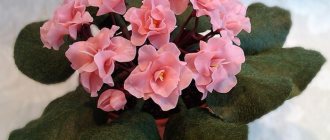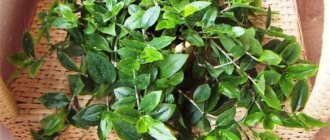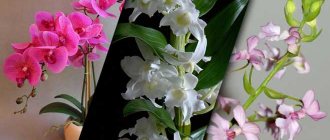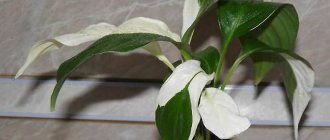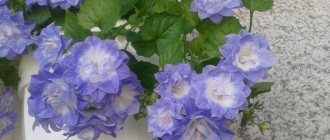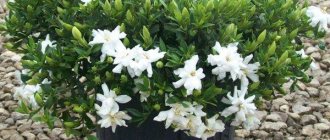floravdome.ru > Beautiful flowering trees and shrubs > Bougainvillea (Bougainvillea)
Beautiful, generously blooming bougainvillea , always attracting attention and arousing admiration, comes from South America. It has taken root well in Europe, North Africa, and has spread throughout Southeast Asia. In warm and mild climates, this liana-like plant grows rapidly, reaching a length of more than 15 meters, blooms profusely and luxuriantly almost all year round, and feels great in the garden, in the wild, and in the city.
But the luxurious appearance of bougainvillea during the flowering period is given not by the flowers at all, but by the brightly colored bracts, heart-shaped, pointed leaves surrounding small light flowers.
The most famous is the naked bougainvillea (B. Glabra Choisy) and its numerous hybrids of various colors - from rich carmine and purple flowers to soft pink and white.
At home, bougainvillea is grown quite simply, does not require particularly difficult conditions, reproduces easily, and blooms well in the summer. An important point in growing is regular pruning of the plant.
Bougainvillea glabra
Bougainvillea glabra
Rest period
Weak dormant period - autumn - winter. At this time, it is recommended to gradually reduce the plant’s daylight hours to 5-6 hours, and lower the air temperature to +7o - +10o.
Watering is moderate. Do not allow the soil to dry out and keep it moderately moist. During the dormant period, bougainvillea undergoes foliage renewal - the plant sheds almost all its old leaves in order to again grow a lush crown during the growing season.
♦ Proper maintenance of the plant during the dormant period contributes to its active growth and lush flowering in the new season.
With proper maintenance, bougainvillea grows actively and requires periodic pruning, both to give a neat shape to the crown of the plant and to stimulate the growth of new shoots and flowering.
Pruning is carried out in early spring, with the resumption of the growing season - dry and overgrown branches are cut to the required length, sometimes by a third or more, which stimulates the growth of new shoots with flower buds and bushiness.
In autumn, branches with faded bracts, weak and dried shoots are pruned.
Branches with young buds are left.
Seeds
The seeds are planted in peat soil and placed in greenhouse conditions at a temperature of +25o - +28o.
Seeds germinate very slowly - the first seeds appear no earlier than after 2 months.
A new plant does not always retain varietal characteristics.
By cuttings
Healthy semi-lignified cuttings up to 10 cm with apical leaves are treated with a root formation stimulator, for example Kornevin, and planted in peat soil or a mixture of peat and sand. They put it in a greenhouse and in a bright, warm (+25o – +26o) place. After the formation of a strong root system, the new plant is transplanted into a separate pot.
Shoots also take root well in water with the addition of Epin (or another growth stimulant).
Growing in apartment conditions
The heat-loving “paper flower” is grown indoors and at home in the middle latitudes of the Russian Federation.
When caring for Bougainvillea at home, it is very important to comply with its environmental requirements.
The flower should be in the sunniest place so that the sun warms it for at least 5 hours. Even the scorching midday rays are not afraid of the flower.
The temperature should not be below 10 degrees at any time of the year. The flower does not like drafts. In summer it is worth taking the plant out onto the balcony. Do not allow precipitation to fall on the bush. When at rest, it is recommended to move it to a cool place (12-16 degrees). The bush does not like frequent changes of location. During the development period, the temperature should not exceed 22-25 degrees.
Air humidity should be increased. Therefore, the air around the indoor plant must be frequently moistened with a spray bottle so that drops of water do not fall on the bracts. You can humidify the air using a container filled with water.
During active growth, the bushes should be watered abundantly so that the soil is constantly moist. To know how to water a flower correctly, you should listen to the advice of flower growers, who claim that you can only moisten the leaves and bush with well-settled or boiled water 1-2 times a week, and in the fall - once every 15-20 days.
Pour water into the pot until it flows out of the holes in the bottom. Do not allow water to stagnate in the pot. Be sure to empty the water from the pan. If leaves fall from a flower in winter, then you need to stop watering until February.
Bougainvillea indoor flowers are propagated by stem cuttings, air layering, grafting, and seeds.
The fertilizers that Bougainvillea needs must contain phosphorus, potassium and iron. Overfeeding with nitrogen fertilizers is unacceptable. Fertilize with fertilizer solutions.
The soil should be universal and light.
The pot should be 2-3 cm larger than the root system along with the soil. A large pot will cause rapid growth of the root system and green mass, and flowering will be weak. A pot that is too tall and wide is not suitable for a bush. At its bottom there must be a drainage layer with a thickness of 30 to 40 mm, made of large pebbles, expanded clay or polystyrene foam.
Replanting bougainvillea
Young plants grow quite actively and require annual replanting, adults are replanted as the soil becomes depleted or the pot becomes full.
♦ Choose a tall pot. When replanting, the pot should be several centimeters larger than the old one. If you choose a pot that is too large, “not the right size,” then the plant, first of all, will begin to grow roots to the detriment of the growth of the above-ground part and flowering.
♦ Transplantation is carried out before the growing season in mid-late March.
♦ The soil is loose and nutritious with the following composition: turf soil, humus, sand, peat in approximately equal proportions. To prevent root diseases, you can add charcoal or ash.
♦ When replanting, damaged roots are removed.
♦ Be sure to add drainage to the bottom of the pot.
♦ To reduce damage to the fragile root system, replanting is done by transshipment: water the plant well and carefully remove the entire earthen ball with roots from the old pot, place the plant in a new pot with a layer of drainage and a small amount of soil and add soil until the container is completely filled.
Spider mite - the plant is entangled in cobwebs.
♦ The plant is washed and treated with a solution of laundry soap. Spray the plant with Aktara.
Mealybug - the leaves dry out, pests in the form of small cotton balls are noticeable on different parts of the plant.
♦ Pests are collected. Treat the leaves with a solution of laundry soap and spray with infusion of garlic or wormwood. Treated with insecticides - Actellik, Fitoverm, Fazol.
If possible, damaged parts are removed.
Aphids - leaves dry out and fall off, pests are visible mainly on the underside of the leaves.
♦ Treat the leaves with a solution of laundry soap and spray with infusion of garlic or wormwood. Treated with insecticides – Actellik, Aktara.
Soft light spots appear on the leaves - violation of the watering regime - excessive. Water the plant only when the top layer of soil dries out; if necessary, check for drying at a depth of several centimeters.
♦ Leaves turn yellow - excessive watering or cold water. In summer, water only when the top layer of soil dries out. Use warm, settled water. In winter, reduce watering to a minimum.
♦ Leaves turn pale and become smaller – lack of nutrients.
♦ Leaves dry – dry air. Spray the leaves in the morning; on hot days, it is possible to spray water over the plant without getting on the leaves.
♦ Does not bloom for a long time - the dormant period is not sufficiently provided; lack of heat, light, improper watering; excess nitrogen fertilizers.
Bougainvillea has many varieties, representing almost all shades of red, purple, lilac, and yellow. There are varieties of mixed colors, for example, white and pink.
Varieties with double flowers and variegated ones have been bred.
The photographs below show some varieties of this beautiful plant.
Bougainvillea glabra Sanderiana
Bougainvillea Snow Purple
Bougainvillea Double Red
Bougainvillea Tomato Red
Bougainvillea Pedro
Bougainvillea Scarlet Glory Orange
Bougainvillea California Gold
Golden Tango Bougainvillea
Bougainvillea Yellow Queen
Bougainvillea Cherry Blossom
Bougainvillea Limberlost Beauty
Bougainvillea Strawberry Lace
Bougainvillea Jamaica White
Bougainvillea Bougainvillea Thai Gold
Share link:
Rate the article!
[Total: 2 Average: 5]
Caring for bougainvillea at home
This showy plant is an evergreen flowering shrub native to the tropical forests of Latin America. Successful maintenance of bougainvillea is a consequence of meeting the basic maintenance requirements of this plant. There are not many of these requirements, and if desired, they can be easily implemented. The plant can be kept either indoors or indoors (in pots), or as an outdoor plant - to decorate the garden or local area.
Flower temperature
This indoor “dweller” is thermophilic. In summer, the optimal temperature for keeping the plant is 20-25 degrees; in winter, the temperature bar can drop to 12 degrees. But temperatures below 5 degrees are critical, and a further decrease threatens the death of the plant.
Orange bougainvillea flowers
Plant lighting requirements
Bougainvillea is a light-loving plant, but still, you should not place the flower in direct sunlight: it will destroy the plant. Direct sunlight should illuminate the flower no more than 3-4 hours a day, mainly in the summer.
In winter, the plant requires much less light. Under natural conditions, this plant chooses its own places to grow. As a rule, these are the southern directions of the walls. In home floriculture, it is necessary to regulate the light regime more carefully.
Features of watering plants
As for watering, this representative of the world of flora needs abundant watering in warm (especially hot) times, and moderate watering in the autumn and winter. You can get your bearings as follows: you should not overfill the soil, but at the same time, the earthen ball should not dry out. In winter, the soil may feel almost dry to the touch, but the substrate should not be allowed to dry out. It is advisable to water the plant with warm, well-drained water. The water can be softer, simulating rain. The plant is “accustomed” to obtaining all the necessary minerals from the soil.
Optimal air humidity
Due to the fact that the plant is moisture-loving, it is necessary to increase the air humidity in the room daily by spraying its leaf blades. This procedure is especially important in the hot summer and during the heating season, when the air is dried out by the radiators of the central heating system. During this period, it is necessary to monitor the humidity of the substrate, preventing it from overdrying.
Pink bougainvillea flowers
Possible problems when growing bougainvillea
Failure to comply with the conditions necessary for the full development of a flower entails negative consequences. However, there is a solution for every problem, so you just need to carefully monitor the plant and respond to its signals in a timely manner.
- Stunted growth - the plant lets you know that the pot is too crowded. Transplant the plant into a container with a large volume;
- Why doesn't bougainvillea bloom ? To avoid asking this question, provide the plant with proper ventilation and adjust the watering regime;
- Does the flower shed its leaves in the summer season ? Most likely he lacks sunlight. If the foliage dries out before falling, more moisture is needed;
- Small young leaves - the plant should be fed immediately;
- Yellow foliage is a possible signal of stagnant moisture in the pot. In this case, it is necessary to adjust the watering mode again;
- Small white spots on the foliage are a sign of mold. There are several ways out of an unpleasant situation. Firstly, you can place the flower in a well-ventilated place. Secondly, it is recommended to reduce the frequency of watering and spraying. Thirdly, you can treat the leaves with a fungicide or remove mold mechanically by wiping the leaves with a soap solution.
- The attack of aphids, scale insects, spider mites, mealybugs is repelled by treatment with insecticides, actellik or alcohol.
Common diseases and pests of bougainvillea
Excessive as well as insufficient watering can cause an indoor flower to begin to shed its leaves and flowers. If the “drought” was short-lived and the moisture supply returned to normal, the plant will quickly “come to its senses.”
The following pests are dangerous for this representative of the flora world: sedentary aphids, mealybugs and scale insects.
If you create the necessary living conditions for this flowering indoor plant, it will give you a beautiful delicate color and become a green decoration for your home.
It is also worth noting that the plant does not tolerate temperature drops below 5 °C. Long periods of such low temperatures can kill bougainvillea. In case of an unfavorable temperature forecast, the plant must be covered in advance with something that conserves heat (spruce branches, cellophane, rags) or moved indoors.
Until recently, bougainvilleas were distant exotic plants, newcomers from warm southern countries. But now more and more plant lovers have a treasured pot with greetings from the sunny summer on their windowsill. And as soon as it appears, many questions come along with it - how to care for it, how to create conditions, how to make friends with this beautiful plant. Most of the fears turn out to be groundless - bougainvillea is a very unpretentious plant, it is undemanding both in terms of soil composition and fertilizers, and in terms of maintenance conditions. But the most important thing to remember about bougainvillea is that it is a southern plant that loves warmth and sun. And your task is to rid it of cold winter conditions and unpleasant drafts. And of course, give it the maximum amount of sun, because to bloom it needs at least 5 hours of bright sunlight per day and preferably on southern, southwestern (or at least southeastern) windows. This is where the main problem of keeping bougainvillea lies - lack of lighting. A plant standing in a shaded place will stretch upward and grow into a large bush, but will not bloom. But what to do if it is not possible to create good conditions for bougainvillea with sufficient natural light? This question is very often asked by customers, so we decided to compile a top list of the most “flowering” varieties that bloom faster than all others, and some can bloom under artificial light. We would like to point out that this list is based on our experience and selection of plants from our collection.
- 1. the first place; it has bloomed several times under artificial lighting, and in the presence of sun it will still bloom as a cutting, and you definitely won’t have to wait long for its scarlet bracts. But this has its drawbacks; when flowering, the plant grows slower, so if you want the plant to grow faster, then you should tear off the bracts from a small cutting.
- Along with this variety, several more varieties can be put in first place: Royal Dauphine (I would like to clarify that this variety is not related to the usual variety Dauphine, they differ in the color of the bracts and the shape of the variegation) and the new addition to the Red Apple collection. These varieties are similar in structure to Rusberry Ice Rosso - they have the same flexible, non-woody trunk for a long time, bush well, but at the same time a fairly compact trunk. And a distinctive feature of this type of variety is the presence of variegated foliage (non-contrasting like Rusberry Ice Rosso and Red Apple, splashy like Royal Dauphine)
2. Second place was given to miniature varieties Mini Thai, Mini Thai Variagata, Pixie Queen
Miniature varieties have many advantages - they are easy to care for, very unpretentious, therefore they are well suited for beginner bougainvillea lovers, they take up little space (but do not think that if the plant has a compact bush, it will not grow vigorously upward, do not forget about the formation bush and pruning) and, among other advantages, they bloom quickly. Unfortunately, we cannot say for sure whether this variety blooms under artificial light, but if there is sun, you will very quickly notice the bracts turning pink under the leaves.
- 3. Third place is occupied by varieties of the Vera series: VeraDeepPurple, VeraWhite, VeraPink, Fifina (this variety is similar to the VeraDeepPurple variety). The variegated form of Vera Variegata still cannot be classified as fast-flowering.
- It is difficult to over-praise the varieties of the Vera series; they surprisingly have collected many positive qualities from other varieties (it’s a pity that they are not terry).
- So why are they so good?
- First of all, it is a compact bush, not so small-leaved and small as to classify them as miniature varieties, but compact enough to be comfortably placed on a windowsill in an apartment (but don’t forget about pruning and pinching). At the same time, the foliage itself on these varieties grows densely and abundantly and, along with the bracts, is a decoration of the plant itself.
- Their second advantage is the abundance of flowering - the thick, tightly knit caps of bracts will give even double varieties a head start
- And of course, the third plus is the speed of flowering, all three varieties will very quickly delight bougainvillea lovers with their flowering, even in not very good lighting they are capable of producing very beautiful flowering.
- It is not for nothing that the Vera Deep Purple variety is one of the most widespread and recognized in the world. But these varieties are not without drawbacks - they do not like rearrangements and can shed leaves and bracts when the light changes, but in most cases this is not a problem - the foliage grows back very quickly.
- 4. fourth place to the BoisDeRoses variety.
- There are several other bougainvillea varieties that bloom as quickly as Bois De Roses, but it makes this list primarily because it blooms under artificial light.
- This variety is the only one on the list that can be called fast-growing (I don’t think it can be considered the fastest-growing, but compared to other varieties on the list, it grows quite quickly). Therefore, it is suitable for those who are not limited in space and want to grow a larger bush.
- In addition to rapid flowering, this variety can delight with cap flowering, which is facilitated by large bracts and abundance of flowering.
- Bois De Roses will also definitely please those who love two-color flowering - at the beginning the bracts are colored beige-yellow and gradually become pink, forming delicate lush clouds of flowers.
- 5. I would like to put terry varieties fifth They take a little longer to bloom than other varieties on the list. But they definitely cannot be classified as difficult to bloom. At the same time, some double varieties also bloom under artificial lighting, which allows dedicated bougainvillea lovers to experiment even with a lack of space and lighting.
- The flowering speed of double varieties is approximately the same, but varieties Double Pink, Pagoda Pink, Limberlost Beaty are usually ready to bloom a little earlier than brighter varieties.
We can talk endlessly about the advantages of terry varieties; without a doubt, they can be classified as the most beautiful and sought-after varieties. Therefore, for plant lovers who want to try growing bougainvillea, double varieties are on the list of must-have purchases.
This could conclude our list of the top 5 fast-blooming bougainvillea varieties. But it would be dishonest not to indicate other varieties that will also bloom quite quickly. Among them are Killy Campbell, Lateritia, Donyo, Donya, Silhouette, Australian Pink. These are no less beautiful varieties, which will be discussed in more detail in other articles.
